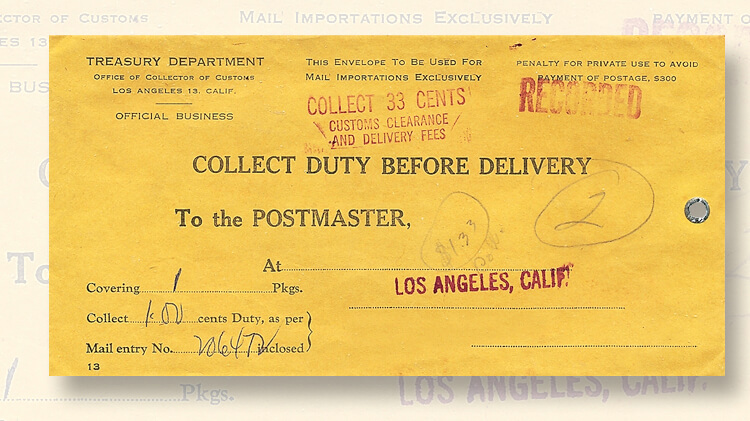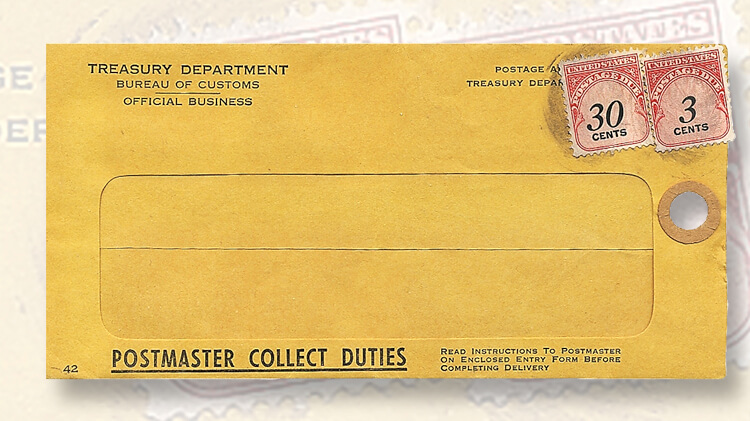US Stamps
Revisiting customs and delivery fees with new examples: Modern U.S. Mail
By Tony Wawrukiewicz
This column for the Linn’s issue of April 14, 2008, presented a discussion of customs clearance and delivery fees and custom duties for a July 6, 1971, parcel item.
That column offered a fairly detailed description of the process for handling the fees in question, and I mentioned that, in my experience, examples of such after mid-1950 were very uncommon.
I still feel that this is true, but I now do have two examples of the 33¢ collection and delivery fees, and present them here.
Connect with Linn’s Stamp News:
Sign up for our newsletter
Like us on Facebook
Follow us on Twitter
Neither item is dated, but the 33¢ amount in fees collected places both items in the May 15, 1957, to Jan. 14, 1968, time period. (As a reminder, from July 1, 1930, until Jan. 2, 1976, for small packets and parcel post, the collection and delivery fees were combined.)
In the first illustration is an undated Treasury Department, Bureau of Customs, official-business envelope with 33¢ in postage due stamps on it (the 3¢ Scott J91 and the 30¢ J98, both issued June 19, 1959).
In the International Mail Transmittal Letter 38 (March 8, 1961), we find: “Post offices will collect the fee of 33 cents from the addressee of every parcel post package on which customs duty or internal revenue tax is collected. … The fee is retained by the Postal Service, and is accounted for by affixing postage-due stamps to the parcel or to a postage-due bill and canceling.”
On the item in the first illustration, the postage due stamps that indicated the payment of the fee by the addressee were not placed in the correct location.
In the second illustration we have another undated and somewhat different example of a Treasury Department, Bureau of Customs, official-business envelope indicating the collection of the 33¢ collection and delivery fees. This envelope includes the “Mail entry No.” that was used to label and identify the incoming package.
The duty amount of $1 and the total amount of $1.33 due from the Los Angeles, Calif., addressee also were listed on this envelope.
The 33¢ in postage due stamps indicating the fee retained by the Postal Service presumably were placed correctly on the parcel or on a postage-due bill.
Tony Wawrukiewicz and Henry Beecher are the co-authors of two useful books on U.S. domestic and international postage rates since 1872. The third edition of the domestic book is now available from the American Philatelic Society, while the international book may be ordered online.
MORE RELATED ARTICLES
Headlines
-
US Stamps
Oct 7, 2024, 3 PMMcMurtrie dismissed as APS education director following Sept. 21 arrest
-
US Stamps
Oct 7, 2024, 12 PMVasiliauskas named president of Mystic Stamp Co.
-
US Stamps
Oct 6, 2024, 5 PMApgar souvenir card available
-
US Stamps
Oct 6, 2024, 4 PMFirst Continental Congress and U.N. stamps receive Scott catalog numbers










